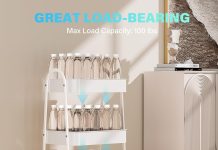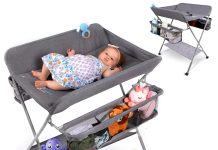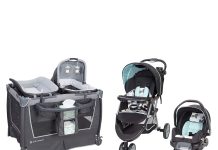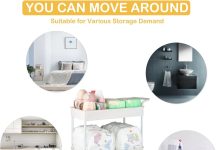In this article, we would like to share some practical tips on how to efficiently organize a changing table. From arranging essential supplies within easy reach to implementing smart storage solutions, we will guide you through the process of creating an organized and functional space for diaper changes. So, if you’re a new parent or simply looking to improve your diaper-changing setup, stick around as we uncover the secrets to maximizing efficiency in this often chaotic but essential area of childcare.
Review contents
1. Essential Supplies
When it comes to organizing a changing table for maximum efficiency, it all starts with having the essential supplies readily available. Stocking up on key items such as diapers, wipes, diaper rash cream, a changing pad, disposable bags, extra clothing, and hand sanitizer is crucial. These supplies ensure that you have everything at your fingertips when it’s time for a diaper change. Plus, having these essentials in stock will save you from scrambling for items during those moments when every second counts.
Diapers
Diapers are, of course, the centerpiece of any changing table setup. It’s important to have an ample supply of diapers in various sizes to accommodate your baby’s growth. Keep them within easy reach, either in a drawer below the changing table or in a designated diaper storage area on the shelf. This way, you won’t have to search for them when it’s time for a change.
Wipes
Wipes are a must-have for any changing table. They allow you to quickly and effectively clean your baby during diaper changes. Keep a dispenser of wipes within arm’s reach to save time and ensure convenience.
Diaper Rash Cream
Diaper rash cream is another essential item that should be readily available. It helps protect your baby’s delicate skin from irritation and prevents diaper rash. Set aside a small space on your changing table dedicated to diaper rash cream, making it easily accessible for every diaper change.
Changing Pad
A changing pad is a practical and comfortable surface for your baby to lay on during diaper changes. Make sure you have a changing pad that fits securely on top of your changing table or dresser. This not only provides a safe and clean surface but also adds an extra layer of comfort for your little one.
Disposable Bags
Having disposable bags on hand is a game-changer for convenient and hygienic diaper disposal. Simply slide a bag over the dirty diaper and tie it up before disposing of it in a diaper pail or trash can. Place a dispenser of disposable bags near your changing table for easy access and to maintain cleanliness.
Extra Clothing
Babies have a knack for making messes, so it’s essential to have spare clothing on hand. Keep a basket or drawer specifically designated for extra clothing next to your changing table. This way, if your baby happens to have a diaper blowout or spit-up incident, you can quickly and easily grab a fresh outfit without leaving their side.
Hand Sanitizer
Hand sanitizer is a valuable addition to any changing table setup. It provides a quick and easy way to sanitize your hands before and after diaper changes. Place a bottle of hand sanitizer within reach of your changing table to promote cleanliness and prevent the spread of germs.
2. Categorizing by Function
To maximize efficiency, it’s helpful to categorize your changing table items by function. This ensures that everything has a designated place and can be easily located when needed. Here are some key categories to consider:
Diapering Essentials
Group together all the items directly related to diaper changes. This includes diapers, wipes, diaper rash cream, disposable bags, and the changing pad. By keeping these items together, you can streamline your diaper changing process and minimize the risk of misplacing anything.
Feeding Supplies
If you use your changing table for feeding purposes as well, it’s a good idea to create a separate section for feeding supplies. This may include bottles, formula, bibs, and burp cloths. By separating feeding essentials from diapering essentials, you can easily grab what you need without searching through multiple items.
Clothing Essentials
Set aside a specific space for clothing items, such as shirts, pants, onesies, and socks. This helps keep your baby’s clothes organized and readily available when getting them dressed after a diaper change. Consider using dividers or labeled bins to further categorize clothing items by size or type.
Toiletries and Healthcare Items
Don’t forget to designate a section for toiletries and healthcare items. This may include items like baby lotion, nail clippers, a thermometer, and any other products you use for your baby’s grooming or healthcare needs. By keeping these items organized together, you can quickly attend to your baby’s non-diaper-related needs without searching through multiple drawers or shelves.
3. Utilizing Storage Space
Efficient storage is key to keeping your changing table organized. Here are some storage solutions to consider:
Shelves and Cubbies
If your changing table has shelves or cubbies, take advantage of them for storing essential items. Use bins or baskets to further divide and categorize items on these shelves. This method allows you to see what you have at a glance and makes it easy to grab items when your hands are full.
Baskets or Bins
Using baskets or bins is a great way to corral smaller items or categorize items within a larger category. For example, you could have a basket for wipes, a bin for diapers, and another basket for diaper rash cream and disposable bags. Labeling these containers can provide additional organization and ensure that everything has its designated spot.
Drawer Dividers
If your changing table has drawers, invest in some drawer dividers to maximize space and keep items separated. This is especially useful for clothing essentials, where you can divide drawers into sections for different clothing sizes or types. Drawer dividers also prevent items from becoming jumbled together, making it easier to find what you need quickly.
Hanging Storage
Consider utilizing hanging storage solutions for items such as towels or clothing. You can hang hooks or a hanging organizer on the side of your changing table to keep these items easily accessible and save space on the table itself.
4. Accessibility and Placement
When organizing your changing table, consider the accessibility and placement of items. Here are some factors to keep in mind:
Location
Choose a convenient location for your changing table that allows easy access from different areas of your home. It’s best to select a spot that is close to where you spend the most time with your baby. This could be in their nursery, your bedroom, or even in a common area such as the living room.
Reachability
Arrange the items on your changing table based on their frequency of use. Place the most frequently used items, such as diapers and wipes, within easy reach. Less frequently used items, like spare clothing or specialty healthcare products, can be stored slightly further away but still within reach.
Safety Considerations
Ensure the safety of your baby by keeping potentially hazardous items out of reach or securely locked away. This includes anything sharp, toxic, or small enough to be a choking hazard. Be mindful of any cords or hanging objects that could pose a risk to your baby’s safety. Always prioritize the security and well-being of your little one when arranging your changing table.
5. Efficient Layout
Creating an efficient layout for your changing table plays a crucial role in maximizing functionality. Here are some aspects to focus on:
Diaper Changing Area
Position the changing pad in the center of your changing table for easy access from both sides. This allows you to change your baby’s diaper from either direction, regardless of where you’re standing. Keep diapering essentials within arm’s reach to minimize the need to step away during the process.
Accessible Storage
Arrange your storage containers and shelves in a way that allows for easy visibility and access. Group items together based on their function or category to streamline the process of finding what you need. Consider using transparent or labeled storage containers to make it even easier to locate specific items.
Workstation and Organization
Designate a specific area on your changing table as a workspace. This is where you can keep items such as hand sanitizer, diaper rash cream, and disposable bags. Having these items within arm’s reach while you’re actively changing your baby’s diaper can save time and reduce the risk of leaving your baby unattended.
6. Containment and Organization
Keeping your changing table well-organized and items within reach is crucial for efficient diaper changes. Here are some strategies for containment and organization:
Diaper Caddy or Organizer
Invest in a diaper caddy or organizer to keep your changing table essentials in one easily transportable container. This allows you to have all your diapering supplies on hand, even if you need to change your baby in a different location. A diaper caddy typically has compartments and pockets to keep items organized within it, making it a practical and efficient solution.
Labeling Containers
Labeling your storage containers or baskets can significantly simplify the process of locating specific items. This is especially helpful if multiple caregivers or family members are involved in the diaper-changing routine. Clear labels make it easy for anyone to find what they need, enhancing efficiency and reducing unnecessary searching.
Keeping Items Within Reach
Ensure that the items you use most frequently, such as diapers and wipes, are always within reach. This minimizes the need to leave your baby unattended or fumble through drawers or bins to find what you need. Regularly check and restock your supplies to maintain a well-stocked and efficient changing table setup.
7. Regular Restocking
To maintain maximum efficiency, it’s essential to establish a regular restocking routine. Here are a couple of practices to consider:
Inventory Checklist
Create an inventory checklist for your changing table supplies. This allows you to keep track of what you have and what needs to be replenished. Regularly review this checklist and restock any items that are running low to ensure you’re always prepared for diaper changes.
Scheduled Restocking Routine
Establish a scheduled routine for restocking your changing table supplies. This can be a weekly or bi-weekly task, depending on the frequency of diaper changes and your baby’s needs. By setting aside dedicated time for restocking, you can avoid running out of essential items and maintain an efficient changing table setup.
8. Safety and Cleanliness
Safety and cleanliness should never be overlooked when organizing a changing table. Here are some important considerations:
Safety Measures
Ensure that your changing table meets safety standards and is securely anchored to the wall or surface it is placed on. Check for any sharp edges or loose parts that could pose a risk to your baby. Always follow safe diaper-changing practices, such as keeping one hand on your baby at all times and never leaving them unattended on a changing table.
Cleaning Supplies
Have cleaning supplies readily available near your changing table to maintain a clean and hygienic environment. This may include disinfectant wipes or spray, paper towels, and baby-safe surface cleaners. Regularly clean your changing table with these supplies to prevent the spread of germs and maintain a safe space for your little one.
Disinfection
Disinfection is essential for preventing the spread of germs and ensuring a hygienic diaper-changing environment. Wipe down the changing pad and any surfaces that come into contact with your baby using baby-safe disinfectant wipes or spray. This helps keep your baby healthy and minimizes the risk of infections or skin irritations.
9. Diaper Pail Management
Proper management of your diaper pail is crucial for maintaining a pleasant and odor-free changing area. Consider the following tips:
Choosing the Right Diaper Pail
Invest in a quality diaper pail that effectively traps odors and seals in unpleasant smells. Look for options that have odor-locking mechanisms or use scented liners or discs to neutralize any odors. Research different models and read reviews to find one that suits your needs and budget.
Managing Odors
To keep your changing area smelling fresh, take steps to manage diaper pail odors. Ensure the diaper pail is regularly emptied and cleaned, and use scented liners or discs if desired. Additionally, it’s a good idea to have an open box or container of baking soda near the diaper pail to absorb any lingering odors.
Changing the Pail Liner
Regularly replace the pail liner to prevent the accumulation of odors and bacteria. As soon as the diaper pail is full or begins to emit a noticeable odor, it’s time to change the liner. Having an extra liner readily available nearby ensures a quick and efficient replacement process.
10. Personalizing the Space
Lastly, don’t forget to add some personal touches to make the changing table space enjoyable and comfortable for both you and your baby. Here are some ideas:
Decorative Elements
Add decorative elements to make the changing table area aesthetically appealing. Hang pictures, artwork, or decals that match the theme of your nursery or reflect your personal taste. Incorporating these elements can help create a pleasant and inviting atmosphere for your little one during diaper changes.
Comfort Features
Consider incorporating comfort features into your changing table setup. This could include adding a soft cushion or cover to the changing pad for added coziness. You can also include a small plush toy or mobile to distract and entertain your baby during diaper changes.
Creative Touches
Get creative with the organization and storage solutions for your changing table. You could repurpose unique containers or use colorful fabric or patterned bins to add a touch of creativity. Don’t be afraid to think outside the box and find storage solutions that reflect your personal style while remaining practical and efficient.
In conclusion, organizing a changing table for maximum efficiency requires careful consideration of essential supplies, categorization by function, effective storage solutions, accessibility and placement, efficient layout, containment and organization methods, regular restocking routines, safety and cleanliness practices, diaper pail management, and personalization efforts. By implementing these strategies, you can create a well-organized and efficient changing table that makes diaper changes a breeze. Remember, a well-organized and comfortable changing area not only saves you time and effort but also creates a peaceful environment for you and your baby.






























